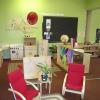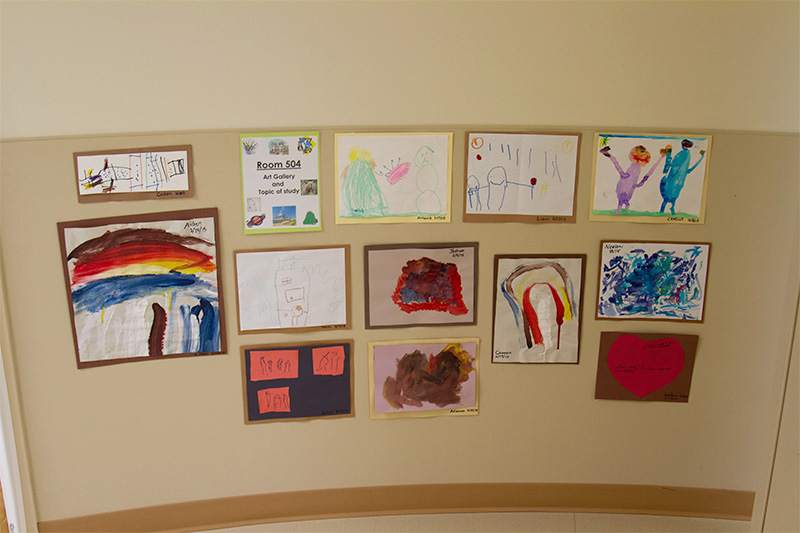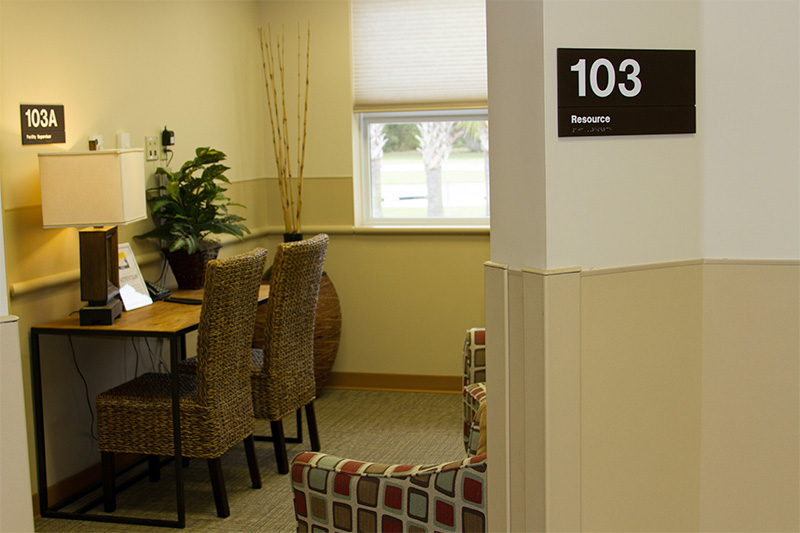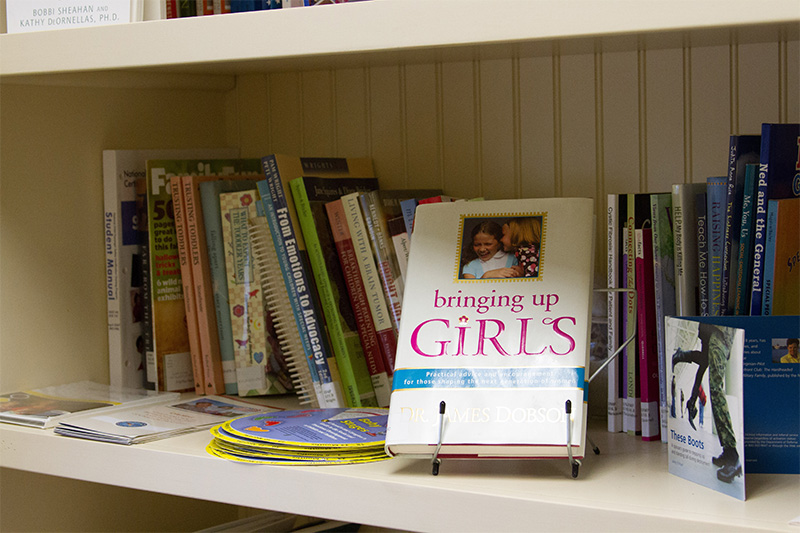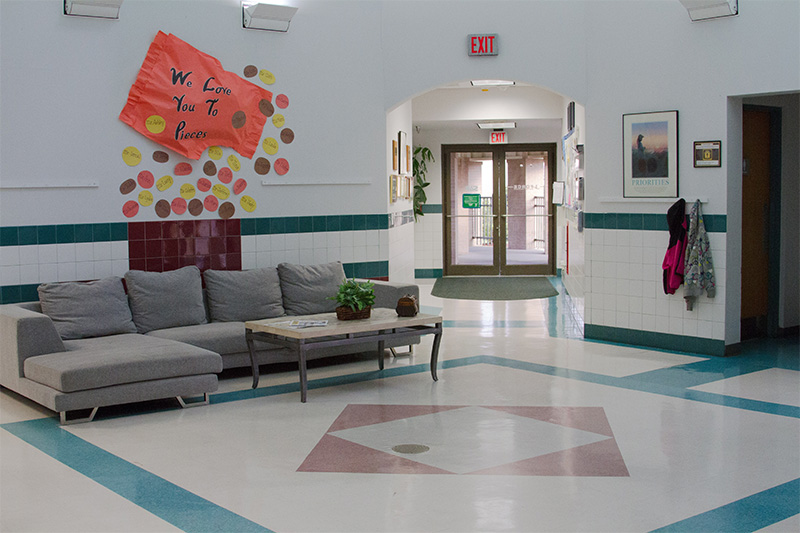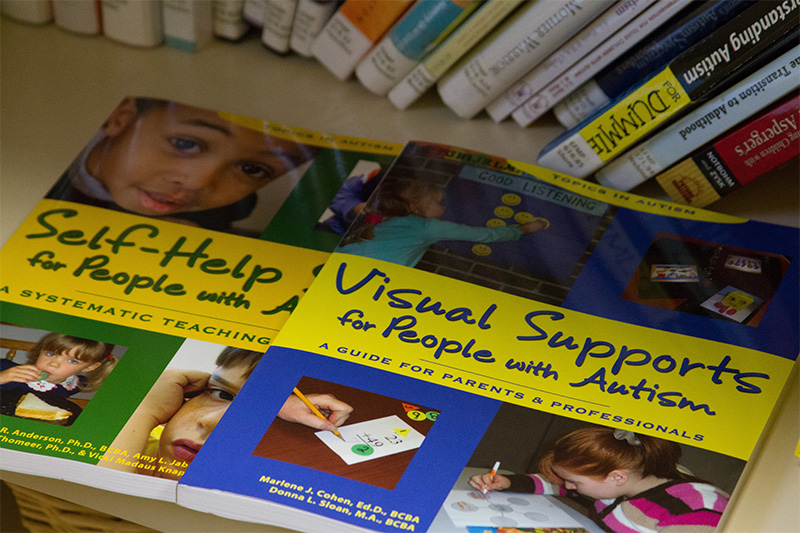- Teach staff members about developmentally appropriate environmental designs for learning.
- Model how to design effective environments and help staff brainstorm solutions.
- Observe and provide feedback on learning environments.
Learn
Teach
What messages do you want your environment to send? How do you want staff members, children, and families to feel while they are in your space? What do you want them to learn?
There are several things to keep in mind as you help staff design or redesign their classroom or program spaces. As an instructional leader, you have the opportunity to help guide staff members’ decisions about their environments. To be effective, you must stay up-to-date on the latest theory and research on high-quality learning environments for infants, toddlers, preschoolers, school-age children, and youth. You can read the age-specific Learning Environment courses for a review. These lessons stress the importance of the physical environment, how the environment sends messages to children, youth and adults about how to appropriately use the space, and how arrangement of the environment can hinder or facilitate staff’s work with children and families. The lessons include information on developing and communicating predictable schedules and routines. In addition, the lessons provide information on constructing indoor and outdoor environments that are:
- Designed to support the interests and development of children and youth, including information on relevant interest or activity areas that could be included based on child age
- Organized to support independence, easy use, and learning
- Full of materials that are developmentally appropriate, authentic and meaningful, open-ended (i.e., materials that can be used in a variety of ways), and that support a variety of learning goals for children or youth
- Simultaneously engaging, with interesting experiences, and calming with home-like attributes
- Supportive of all children and youth
You must also be able to communicate this information to staff members. This lesson will help you identify high-quality environments and provide suggestions for helping staff members continuously improve their learning environments. Although many staff members view the environment as an expression of their creativity and approach to teaching, you hold the ultimate responsibility for ensuring that environments are designed for learning.
Many staff members may need you to provide them with information about child development. Make sure staff members understand the unique needs of the age group with which they work:
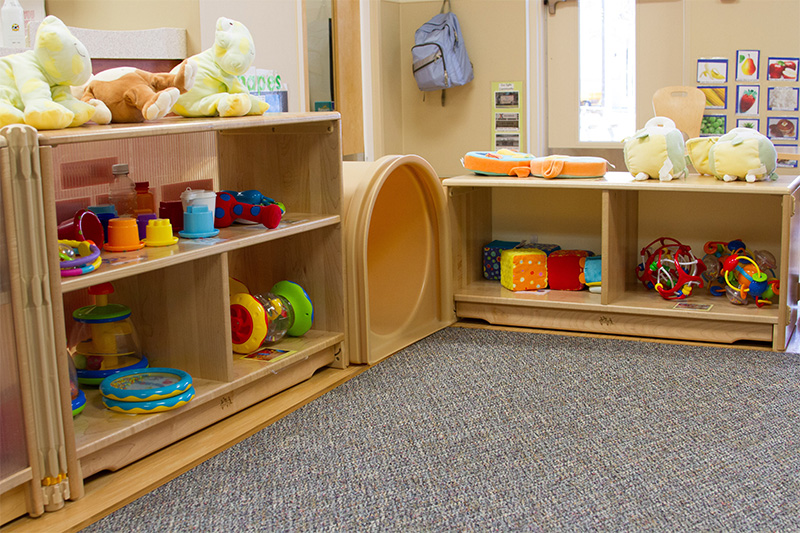 Infants use their senses to explore the world around them. The environment should be set up to encourage this exploration, but safety and supervision should be primary concerns. Infants can do a lot! As infants learn and grow, their needs change. After 6 months of age, children are ready to explore a bit more broadly.
Infants use their senses to explore the world around them. The environment should be set up to encourage this exploration, but safety and supervision should be primary concerns. Infants can do a lot! As infants learn and grow, their needs change. After 6 months of age, children are ready to explore a bit more broadly.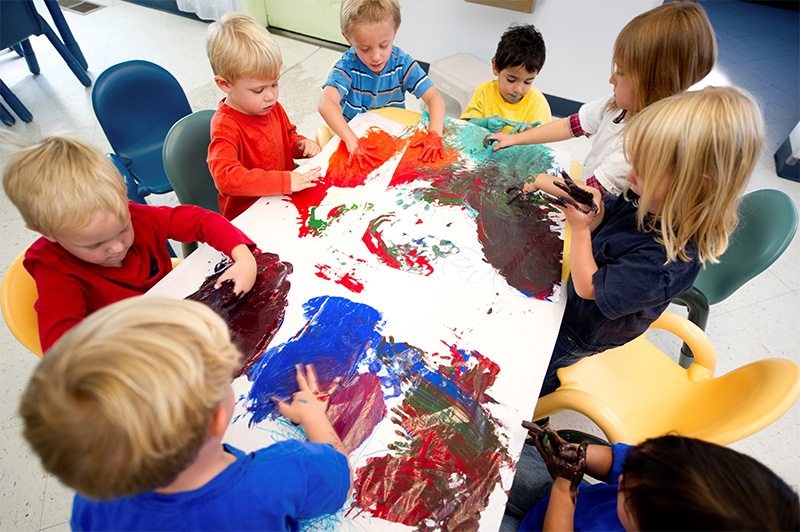 Toddlers are also explorers, but their new mobility has broadened the world of exploration possibilities. Toddlers take risks and test their own limits. The environment should maintain safety while allowing toddlers to practice their new independence.
Toddlers are also explorers, but their new mobility has broadened the world of exploration possibilities. Toddlers take risks and test their own limits. The environment should maintain safety while allowing toddlers to practice their new independence.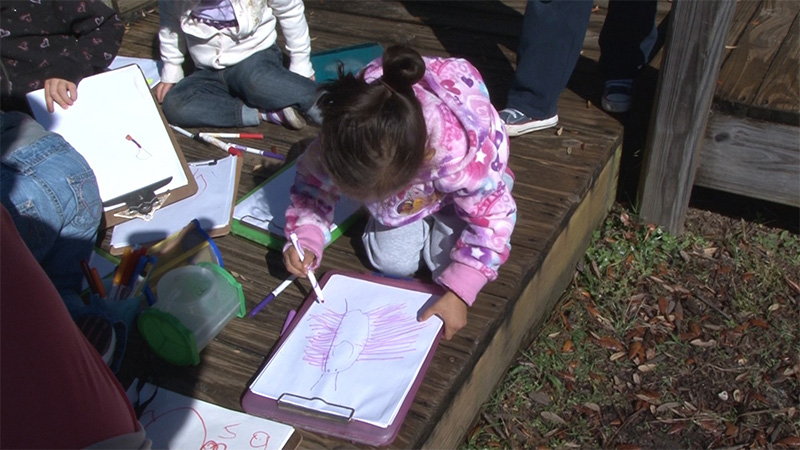 Preschoolers are making sense of the world around them. They are able to explore more independently, and they can move confidently and quickly. They need a variety of objects and settings to explore, manipulate, and create. The environment should spark their creativity, but it should also help them practice important independent skills, such as hand washing and dressing.
Preschoolers are making sense of the world around them. They are able to explore more independently, and they can move confidently and quickly. They need a variety of objects and settings to explore, manipulate, and create. The environment should spark their creativity, but it should also help them practice important independent skills, such as hand washing and dressing.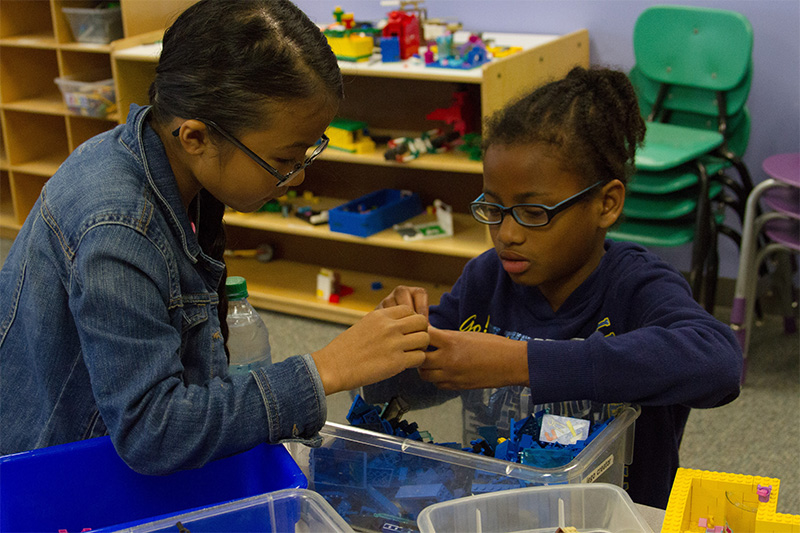 School-age children need many of the same experiences as preschoolers, but they are ready for more sophistication, independence, and challenge. The environment should allow them to identify peer groups, work alone or with others, and select materials and experiences that interest them.
School-age children need many of the same experiences as preschoolers, but they are ready for more sophistication, independence, and challenge. The environment should allow them to identify peer groups, work alone or with others, and select materials and experiences that interest them.
You must be prepared to teach staff members about the role the environment plays in the curriculum and in child behavior. Talk to staff members about how their environments are designed to support engagement and active learning. Also be prepared to encourage staff members to look at their environments first when challenging behaviors occur.
Model
You are the content specialist in your program, so it is your job to be a role model for effective practices. You should have an active role in designing environments. Help staff members arrange their spaces. As you do so, talk about why it is important to arrange environments in systematic ways (separating loud and quiet spaces, providing boundaries, etc.). Spend time talking about the space, sharing organization tips, and helping move furniture. Brainstorm together when problems arise. Model looking at the environment first when challenging behaviors occur. Ask questions like:
- What do you think this environment is communicating to the children or youth?
- What are your goals for this space?
- How do you think children or youth should use this space?
- Is it easy to do what needs to be done here? Why or why not? What would make it easier?
- What problems are children having? What messages do you think they are trying to send with their behavior?
- For older children and youth, what do the children themselves say about the environment? What are their ideas and dreams about the space?
Model curiosity and problem solving as you work with staff members. When a space needs to be arranged or rearranged, help staff members list all the activities, events, and materials that the space should accommodate. Use that list to set goals for the space and clearly define spaces that serve different functions. Also, keep open lines of communication among staff members who work different shifts in the same space. It is important that all staff members understand the purposes behind environmental arrangement.
Finally, work with your program’s management to make sure that your program’s shared spaces communicate the same messages as individual classrooms. Just as staff members carry the responsibility of designing and maintaining their classroom environments and assuring they are safe, you can model many positive environmental strategies by creating shared spaces that embody the qualities you want your classroom environments to express. For the program's shared spaces consider the following questions:
Observe
It is your responsibility to ensure that staff members provide high-quality, engaging environments. As with safety, your program may have tools to evaluate the quality of indoor and outdoor environments. You may use the competency checklist housed within each direct-care track of the Virtual Lab School Learning Environments course, or several environmental rating scales are commercially available (ITERS-R, ECERS-R, SACERS). You can also use the National Association for the Education of Young Children environment standards or other tools developed for school-age programs. These tools can provide valuable information to help focus a staff member’s professional development around the learning environments and materials they provide.
Observing and talking with staff members are the best means for assessing the strengths and meeting the challenges of their learning environments. It is important for you to know each staff member’s individual strengths and challenges. You may need to support consistency across different shifts among staff members who work in the same classroom.
Let’s begin by taking another look at a classroom that you first were introduced to in the Safety Course. Making simple improvements to an environment often can have a major impact on the overall classroom experience—including safety and learning. You’ve already watched this video and thought about the safety implications. Now, take some time to think about how this space affects learning.
Infant & Toddler Learning Environment
Reflecting on Strengths and Needs in the Learning Environment
What did you notice about this environment? Did it maximize opportunities for learning? Did it provide a strong foundation for the curriculum? As a trainer or coach, it is your responsibility to provide supports so the answers to the last two questions are “Yes!” Think about what specific strategies a trainer, coach, and classroom team might discuss to help maximize learning in this environment. In the Safety Course, the trainer, coach, and teachers discussed creating “zones” for easy supervision, developing a role-by-responsibility matrix so adults knew what to do at all times in each zone, and taking data on “hot spots” in the classroom. These same steps can be powerful ways to promote learning. In this case, we would begin to provide the staff members with some rationale for why and how zones and active supervision promote learning. Here is an example of what you might say and do to support this team:
See | You Saw:
|
|---|---|
Say | What You Might Say:
|
Do | What You Might Do:
|
Resources to Strengthen Learning Environments
All of us need the right tools to do our jobs. Use the information you have gathered to connect staff members with resources they need. You might model a skill, arrange for a staff member to observe in another classroom or program, bring in materials from a lending library, or brainstorm new ways to arrange a space. For example, a variety of commercial vendors offer free sample classroom blueprints—the company that sells your program’s furniture may have resources you can find online. You could compare the strengths and weaknesses of each and brainstorm ways you could apply designs with the furniture and materials you already have. You might also help connect staff members with resources about teaming, or working with each other to solve problems. The University of Minnesota REACH program has a variety of resources for developing your coaching skills and helping support adult learners. You may also complete the Virtual Lab School Focused Topics course Using the VLS: Coaching to Enhance Practice.
To help you think more about the learning environments you want to foster in your program, look briefly at some examples of learning environments developed for young children and school-age children and youth. Take some time to think about how these spaces affect learning.
Additional Examples of Learning Environments
As a trainer or coach, you will likely see a range of environments across a range of age groups with varying levels of quality. The first video you saw in this lesson represented an infant and toddler setting. Watch the following videos that represent preschool and school-age settings. Each video ends with a summary of how you might follow up with the staff members.
A Range of Preschool Learning Environments
Use the menu at the left or the pager below to cycle through scenarios
See | You Saw:
|
|---|---|
Say | What You Might Say:
|
Do | What You Might Do:
|
See | You Saw:
|
|---|---|
Say | What You Might Say:
|
Do | What You Might Do:
|
A Range of School-Age Learning Environments
Use the menu at the left or the pager below to cycle through scenarios
See | What a Coach Saw:
|
|---|---|
Say | What a Coach Might Say:
|
Do | What You Might Do:
|
See | What a Coach Saw:
|
|---|---|
Say | What a Coach Might Say:
|
Do | What You Might Do:
|
Completing This Course
For more information on what to expect in this course and a list of the accompanying Learn, Explore and Apply resources and activities offered throughout the lessons, visit the Training & Curriculum Specialist Learning Environments Course Guide.
To support the professional development of the direct care staff members or family child care providers you oversee, you can access their corresponding Course Guides:
- Infant & Toddler Learning Environments Course Guide
- Preschool Learning Environments Course Guide
- School-Age Learning Environments Course Guide
- Family Child Care Learning Environments Course Guide
Explore
Take some time to evaluate how your program’s environment supports learning. Complete the Utilizing The Environment To Support Learning activity to help you. Discuss your reflections with your team.
Apply
Observations should be anchored in some sort of measurement system. This will help ensure that you coach consistently across staff members and settings. It also helps you provide objective, factual feedback to staff members about their learning environments. The Tools for Observing the Learning Environment guide provides a brief annotated list of common environmental observation tools. This list is not exhaustive. Check with your administrator for tools your program recommends.
Use the Organizing Spaces for Development and Learning Best Practices Checklist as a focused observation tool to support staff that have completed the Learning Environments course but may need additional support or follow up on creating spaces that promote learning. This checklist provides an easy way to follow up on goals set around this topic and specific feedback to staff members about what you observed.
Glossary
Demonstrate
Afterschool Alliance (2020). Resources to promote belonging and inclusion. https://afterschoolalliance.org/afterschoolsnack/Tools-to-Build-On-Resources-and-guides-for-parents-and_06-03-2020.cfm
Anti-Defamation League (2012). How do I create a bias-free learning environment.https://notoleranceforantisemitism.adl.org/resources/tools-and-strategies/how-do-i-create-bias-free-learning-environment
Barton, E. E., & Smith, B. J. (2015). The preschool inclusion toolbox: How to build and lead a high-quality program. Baltimore, MD: Brookes.
Centers for Disease Control and Prevention (2021). Out of school time supports students’ health and learning. https://www.cdc.gov/healthyschools/ost.htm
Childcare Aware (2021). Brain building tips for early childhood environments. https://www.childcareaware.org/providers/brain-building-for-child-care-programs/early-childhood-classrooms/
Cultivate Learning (2021). Circle time magazine big kids edition season 4: Creating safe environments. https://cultivatelearning.uw.edu/circle-time-magazine/season-4/episode-1/
Center on the Social and Emotional Foundations for Early Learning (CSEFEL). Inventory of practices for promoting children’s social emotional competence. (2010) http://csefel.vanderbilt.edu/modules/module1/handout4.pdf
Curtis, D., & Carter, M. (2014). Designs for living and learning: Transforming early childhood environments (2nd ed). St. Paul, MN: Redleaf Press.
Dodge, D. T., Colker, L. J., & Heroman, C. (2017). The creative curriculum for preschool (6th ed.). Washington, DC: Teaching Strategies, Inc.
Greenman, J. (2017). Caring spaces, learning places: Children’s environments that work (2nd ed). Redmond, WA: Exchange Press, Inc.
Grisham-Brown, J., Hemmeter, M. L., & Pretti-Frontczak, K. (2017). Blended practices for teaching young children in inclusive settings (2nd ed). Baltimore, MD: Brookes Publishing Co.
Harms, T., Cryer, D., & Clifford, R. M. (2019). Family child care environment rating scale, (3rd ed.). New York: Teachers College Press.
Harms, T., Cryer, D. and Clifford, R.M. (2014). Early childhood environment rating scale, (3rd ed). New York: Teachers College Press.
Harms, T., D. Cryer & R.M. Clifford. (2017). Infant/Toddler environment rating scale, (3rd ed). New York: Teachers College Press.
Harms, T., Jacobs, E. V., & White, D. R. (2013). School-Age care environment rating scale (rev. ed.). New York: Teachers College Press.
IRIS Center (2021). Early childhood environments. https://iris.peabody.vanderbilt.edu/module/env/cresource/q1/p01/
McMullen, M.B., & Brody, D. (2022). Infants and Toddlers at Play: Choosing the right stuff for learning and development. Washington, DC: National Association for the Education of Young Children
New York University. (2017, November 6). Afterschool program environments linked to academic confidence and skills. ScienceDaily. https://www.sciencedaily.com/releases/2017/11/171106112233.htm
Teaching Strategies (2021). Five reflective questions for evaluating your physical environment. https://teachingstrategies.com/blog/physical-classroom-environment/
University of Minnesota REACH. (2020) Supporting families through research and outreach. https://reachfamilies.umn.edu/


